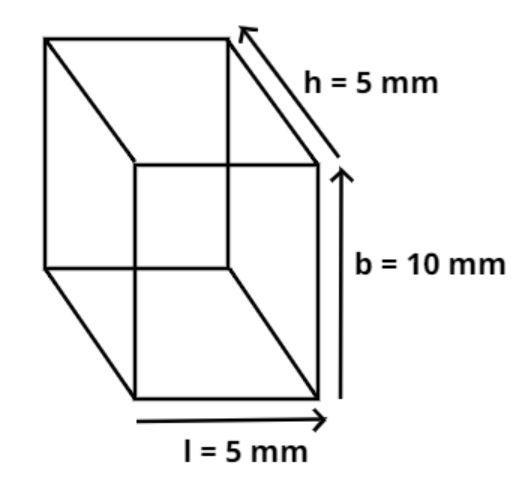
The dimensions of a rectangular block measured with calipers having least count of 0.01 cm are 5mm
Answer
147k+ views
- Hint: In this apply the concept that volume of the cuboid is the multiplication of its respective length, breadth and height and later on in the solution use the concept that to find the maximum possible error in the volume calculate all the % error for the respective sides and add then so use these properties to reach the solution of the question.
Formula used –
Complete step-by-step solution -

Given data:
Least count in the measurement of the dimensions of the rectangular block (i.e. error in measurements) are,
Where l, b and h are the length, breadth and height of the rectangular box.
Now the given dimension of the rectangular box = 5mm
So let l = 5 mm, b = 10 mm and h = 5 mm.
Now as we know that 1 mm = 0.1 cm
Therefore l = 5mm = 0.5cm, b = 10mm = 1 cm and h = 5mm = 0.5cm.
Now as we know that the volume of the cuboid (i.e. rectangular block) =
And the percentage error in any of its sides is the ratio of error in the respective side to length of the respective side multiplied by 100.
So the % error in the length is
Similarly % error in the breadth is
% error in the height is
% error in the volume is
So the maximum percentage error in the volume is the addition of the respective percentage error in the length, breadth and height of the rectangular block.
Now substitute the values we have,
Now simplify the above equation we have,
So this is the required answer.
Hence option (A) is the correct answer.
Note – Whenever we face such types of questions the key concept involved here the percentage error in any of its side is the ratio of error in the respective side to length of the respective side multiplied by 100, so the maximum possible error in the volume is the sum of all the % error of the respective sides as above shown so just substitute the values and simplify, we will get the required answer.
Formula used –
Complete step-by-step solution -

Given data:
Least count in the measurement of the dimensions of the rectangular block (i.e. error in measurements) are,
Where l, b and h are the length, breadth and height of the rectangular box.
Now the given dimension of the rectangular box = 5mm
So let l = 5 mm, b = 10 mm and h = 5 mm.
Now as we know that 1 mm = 0.1 cm
Therefore l = 5mm = 0.5cm, b = 10mm = 1 cm and h = 5mm = 0.5cm.
Now as we know that the volume of the cuboid (i.e. rectangular block) =
And the percentage error in any of its sides is the ratio of error in the respective side to length of the respective side multiplied by 100.
So the % error in the length is
Similarly % error in the breadth is
% error in the height is
% error in the volume is
So the maximum percentage error in the volume is the addition of the respective percentage error in the length, breadth and height of the rectangular block.
Now substitute the values we have,
Now simplify the above equation we have,
So this is the required answer.
Hence option (A) is the correct answer.
Note – Whenever we face such types of questions the key concept involved here the percentage error in any of its side is the ratio of error in the respective side to length of the respective side multiplied by 100, so the maximum possible error in the volume is the sum of all the % error of the respective sides as above shown so just substitute the values and simplify, we will get the required answer.
Recently Updated Pages
How to find Oxidation Number - Important Concepts for JEE

How Electromagnetic Waves are Formed - Important Concepts for JEE

Electrical Resistance - Important Concepts and Tips for JEE

Average Atomic Mass - Important Concepts and Tips for JEE

Chemical Equation - Important Concepts and Tips for JEE

Concept of CP and CV of Gas - Important Concepts and Tips for JEE

Trending doubts
JEE Main 2025 Session 2: Application Form (Out), Exam Dates (Released), Eligibility, & More

JEE Main Exam Marking Scheme: Detailed Breakdown of Marks and Negative Marking

JEE Main 2025: Derivation of Equation of Trajectory in Physics

Electric Field Due to Uniformly Charged Ring for JEE Main 2025 - Formula and Derivation

JEE Main Participating Colleges 2024 - A Complete List of Top Colleges

Degree of Dissociation and Its Formula With Solved Example for JEE

Other Pages
JEE Advanced Marks vs Ranks 2025: Understanding Category-wise Qualifying Marks and Previous Year Cut-offs

JEE Advanced 2025: Dates, Registration, Syllabus, Eligibility Criteria and More

Units and Measurements Class 11 Notes: CBSE Physics Chapter 1

NCERT Solutions for Class 11 Physics Chapter 1 Units and Measurements

Motion in a Straight Line Class 11 Notes: CBSE Physics Chapter 2

JEE Advanced Weightage 2025 Chapter-Wise for Physics, Maths and Chemistry




